light VOLVO V60 2017 Owner´s Manual
[x] Cancel search | Manufacturer: VOLVO, Model Year: 2017, Model line: V60, Model: VOLVO V60 2017Pages: 406, PDF Size: 9.65 MB
Page 5 of 406
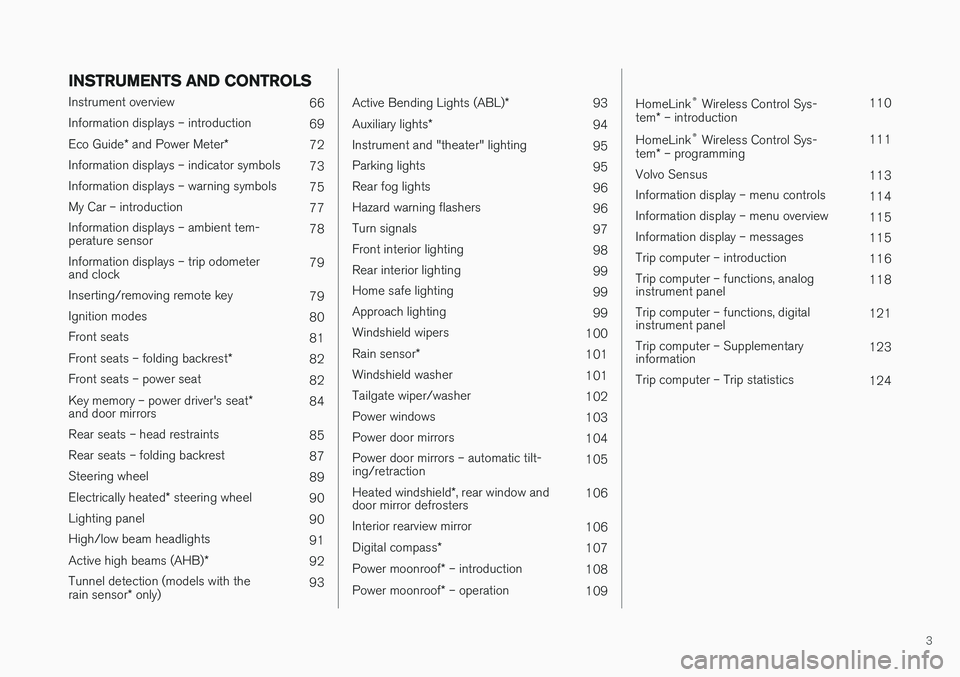
3
INSTRUMENTS AND CONTROLS
Instrument overview 66
Information displays – introduction 69
Eco Guide * and Power Meter *
72
Information displays – indicator symbols 73
Information displays – warning symbols 75
My Car – introduction 77
Information displays – ambient tem- perature sensor 78
Information displays – trip odometerand clock 79
Inserting/removing remote key 79
Ignition modes 80
Front seats 81
Front seats – folding backrest *
82
Front seats – power seat 82
Key memory – power driver's seat *
and door mirrors 84
Rear seats – head restraints 85
Rear seats – folding backrest 87
Steering wheel 89
Electrically heated * steering wheel
90
Lighting panel 90
High/low beam headlights 91
Active high beams (AHB) *
92
Tunnel detection (models with the rain sensor * only) 93
Active Bending Lights (ABL)
*
93
Auxiliary lights *
94
Instrument and "theater" lighting 95
Parking lights 95
Rear fog lights 96
Hazard warning flashers 96
Turn signals 97
Front interior lighting 98
Rear interior lighting 99
Home safe lighting 99
Approach lighting 99
Windshield wipers 100
Rain sensor *
101
Windshield washer 101
Tailgate wiper/washer 102
Power windows 103
Power door mirrors 104
Power door mirrors – automatic tilt- ing/retraction 105
Heated windshield *, rear window and
door mirror defrosters 106
Interior rearview mirror 106
Digital compass *
107
Power moonroof * – introduction
108
Power moonroof * – operation
109
HomeLink®
Wireless Control Sys-
tem * – introduction 110
HomeLink ®
Wireless Control Sys-
tem * – programming 111
Volvo Sensus 113
Information display – menu controls 114
Information display – menu overview 115
Information display – messages 115
Trip computer – introduction 116
Trip computer – functions, analog instrument panel 118
Trip computer – functions, digitalinstrument panel 121
Trip computer – Supplementaryinformation 123
Trip computer – Trip statistics 124
Page 9 of 406
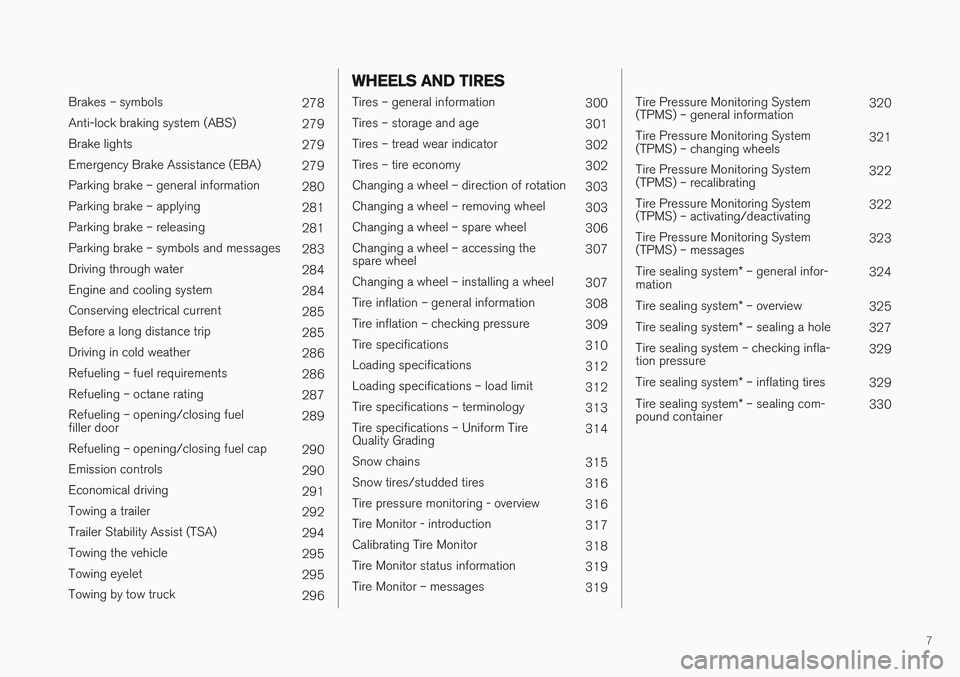
7
Brakes – symbols 278
Anti-lock braking system (ABS) 279
Brake lights 279
Emergency Brake Assistance (EBA) 279
Parking brake – general information 280
Parking brake – applying 281
Parking brake – releasing 281
Parking brake – symbols and messages 283
Driving through water 284
Engine and cooling system 284
Conserving electrical current 285
Before a long distance trip 285
Driving in cold weather 286
Refueling – fuel requirements 286
Refueling – octane rating 287
Refueling – opening/closing fuel filler door 289
Refueling – opening/closing fuel cap 290
Emission controls 290
Economical driving 291
Towing a trailer 292
Trailer Stability Assist (TSA) 294
Towing the vehicle 295
Towing eyelet 295
Towing by tow truck 296
WHEELS AND TIRES
Tires – general information300
Tires – storage and age 301
Tires – tread wear indicator 302
Tires – tire economy 302
Changing a wheel – direction of rotation 303
Changing a wheel – removing wheel 303
Changing a wheel – spare wheel 306
Changing a wheel – accessing the spare wheel 307
Changing a wheel – installing a wheel 307
Tire inflation – general information 308
Tire inflation – checking pressure 309
Tire specifications 310
Loading specifications 312
Loading specifications – load limit 312
Tire specifications – terminology 313
Tire specifications – Uniform TireQuality Grading 314
Snow chains 315
Snow tires/studded tires 316
Tire pressure monitoring - overview 316
Tire Monitor - introduction 317
Calibrating Tire Monitor 318
Tire Monitor status information 319
Tire Monitor – messages 319
Tire Pressure Monitoring System (TPMS) – general information320
Tire Pressure Monitoring System(TPMS) – changing wheels 321
Tire Pressure Monitoring System(TPMS) – recalibrating 322
Tire Pressure Monitoring System(TPMS) – activating/deactivating 322
Tire Pressure Monitoring System(TPMS) – messages 323
Tire sealing system * – general infor-
mation 324
Tire sealing system * – overview
325
Tire sealing system * – sealing a hole
327
Tire sealing system – checking infla-tion pressure 329
Tire sealing system * – inflating tires
329
Tire sealing system * – sealing com-
pound container 330
Page 10 of 406
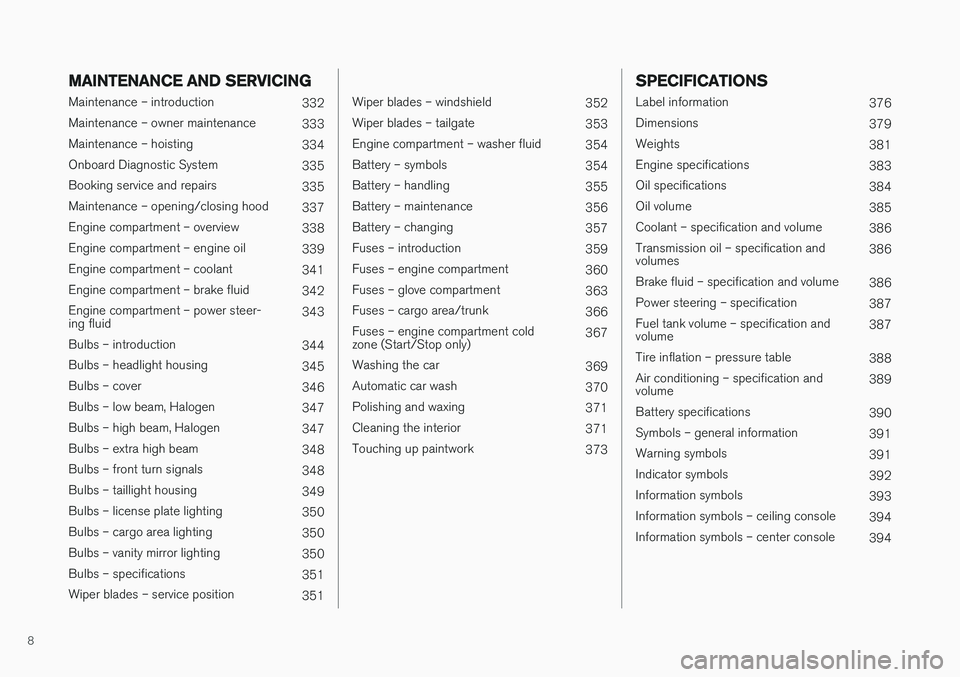
8
MAINTENANCE AND SERVICING
Maintenance – introduction332
Maintenance – owner maintenance 333
Maintenance – hoisting 334
Onboard Diagnostic System 335
Booking service and repairs 335
Maintenance – opening/closing hood 337
Engine compartment – overview 338
Engine compartment – engine oil 339
Engine compartment – coolant 341
Engine compartment – brake fluid 342
Engine compartment – power steer- ing fluid 343
Bulbs – introduction 344
Bulbs – headlight housing 345
Bulbs – cover 346
Bulbs – low beam, Halogen 347
Bulbs – high beam, Halogen 347
Bulbs – extra high beam 348
Bulbs – front turn signals 348
Bulbs – taillight housing 349
Bulbs – license plate lighting 350
Bulbs – cargo area lighting 350
Bulbs – vanity mirror lighting 350
Bulbs – specifications 351
Wiper blades – service position 351
Wiper blades – windshield352
Wiper blades – tailgate 353
Engine compartment – washer fluid 354
Battery – symbols 354
Battery – handling 355
Battery – maintenance 356
Battery – changing 357
Fuses – introduction 359
Fuses – engine compartment 360
Fuses – glove compartment 363
Fuses – cargo area/trunk 366
Fuses – engine compartment cold zone (Start/Stop only) 367
Washing the car 369
Automatic car wash 370
Polishing and waxing 371
Cleaning the interior 371
Touching up paintwork 373
SPECIFICATIONS
Label information376
Dimensions 379
Weights 381
Engine specifications 383
Oil specifications 384
Oil volume 385
Coolant – specification and volume 386
Transmission oil – specification and volumes 386
Brake fluid – specification and volume 386
Power steering – specification 387
Fuel tank volume – specification andvolume 387
Tire inflation – pressure table 388
Air conditioning – specification andvolume 389
Battery specifications 390
Symbols – general information 391
Warning symbols 391
Indicator symbols 392
Information symbols 393
Information symbols – ceiling console 394
Information symbols – center console 394
Page 15 of 406
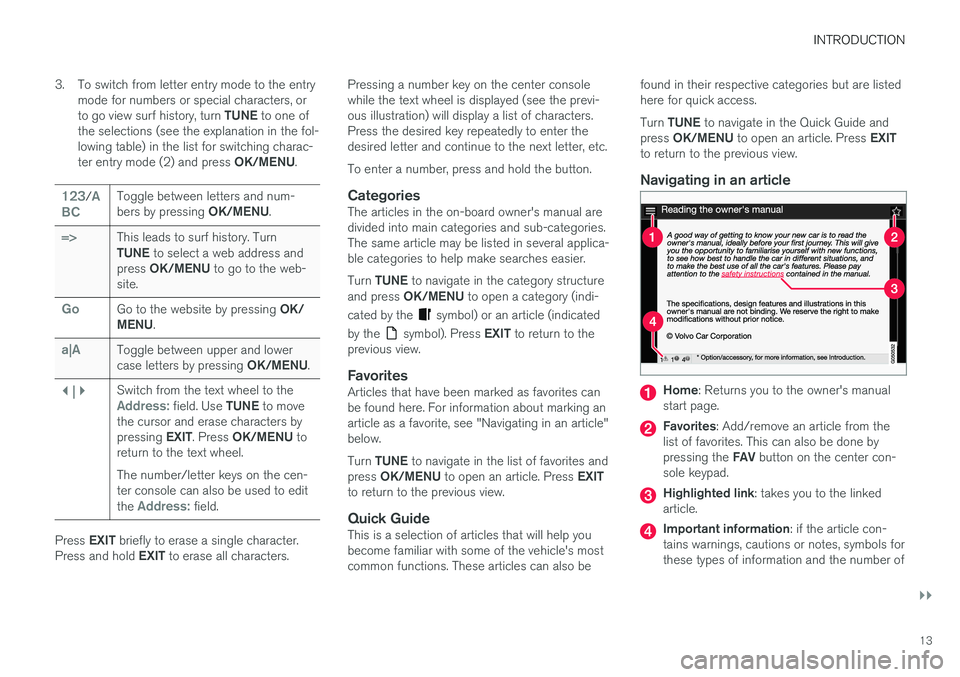
INTRODUCTION
}}
13
3. To switch from letter entry mode to the entry
mode for numbers or special characters, or to go view surf history, turn TUNE to one of
the selections (see the explanation in the fol- lowing table) in the list for switching charac- ter entry mode (2) and press OK/MENU.
123/A
BCToggle between letters and num- bers by pressing OK/MENU.
=>This leads to surf history. Turn TUNE to select a web address and
press OK/MENU to go to the web-
site.
GoGo to the website by pressing OK/
MENU .
a|AToggle between upper and lower case letters by pressing OK/MENU.
| | }Switch from the text wheel to theAddress: field. Use TUNE to move
the cursor and erase characters by pressing EXIT. Press OK/MENU to
return to the text wheel. The number/letter keys on the cen- ter console can also be used to edit the
Address: field.
Press EXIT briefly to erase a single character.
Press and hold EXIT to erase all characters. Pressing a number key on the center console while the text wheel is displayed (see the previ-ous illustration) will display a list of characters.Press the desired key repeatedly to enter thedesired letter and continue to the next letter, etc. To enter a number, press and hold the button.
CategoriesThe articles in the on-board owner's manual are divided into main categories and sub-categories.The same article may be listed in several applica-ble categories to help make searches easier. Turn
TUNE to navigate in the category structure
and press OK/MENU to open a category (indi-
cated by the
symbol) or an article (indicated
by the
symbol). Press EXIT to return to the
previous view.
FavoritesArticles that have been marked as favorites can be found here. For information about marking anarticle as a favorite, see "Navigating in an article"below. Turn TUNE to navigate in the list of favorites and
press OK/MENU to open an article. Press EXIT
to return to the previous view.
Quick GuideThis is a selection of articles that will help you become familiar with some of the vehicle's mostcommon functions. These articles can also be found in their respective categories but are listedhere for quick access. Turn
TUNE to navigate in the Quick Guide and
press OK/MENU to open an article. Press EXIT
to return to the previous view.
Navigating in an article
Home : Returns you to the owner's manual
start page.
Favorites : Add/remove an article from the
list of favorites. This can also be done by pressing the FAV button on the center con-
sole keypad.
Highlighted link : takes you to the linked
article.
Important information : if the article con-
tains warnings, cautions or notes, symbols for these types of information and the number of
Page 16 of 406

||
INTRODUCTION
14such texts in the article will be displayed here.
Turn TUNE to navigate among the links or scroll
in an article. When you have scrolled to thebeginning/end of an article, you can return to thestart page or a favorite by scrolling one additional step up/down. Press OK/MENU to activate a
selection or highlighted link. Press EXIT to return
to the previous view.
Related information
• Information on the Internet (p. 21)
Owner's information
Your vehicle is equipped with a screen on which you can display information about your vehicle'sfeatures and functions. The printed owner'smanual supplements the on-board informationand contains important texts, the latest updatesand instructions that can be useful in situationswhen it is not practical to read the information onthe screen. Changing the language used for the on-board information could mean that some of the infor-mation displayed may not comply with nationalor local statutes and regulations.NOTE
• Do not export your Volvo to another country before investigating that coun-try's applicable safety and exhaust emis-sion requirements. In some cases it maybe difficult or impossible to comply withthese requirements. Modifications to theemission control system(s) may renderyour Volvo not certifiable for legal opera-tion in the U.S., Canada and other coun-tries.
• All information, illustrations and specifica-tions contained in this manual are basedon the latest product information availa-ble at the time of publication. Please notethat some vehicles may be equipped dif-ferently, depending on market-specificadaptations or special legal requirements.Optional equipment described in thismanual may not be available in all mar-kets.
• Some of the illustrations shown aregeneric and are intended as examplesonly, and may not depict the exact modelfor which this owner's information isintended.
• Volvo reserves the right to make modeland product changes at any time, or tochange specifications or design withoutnotice and without incurring obligation.
Page 20 of 406
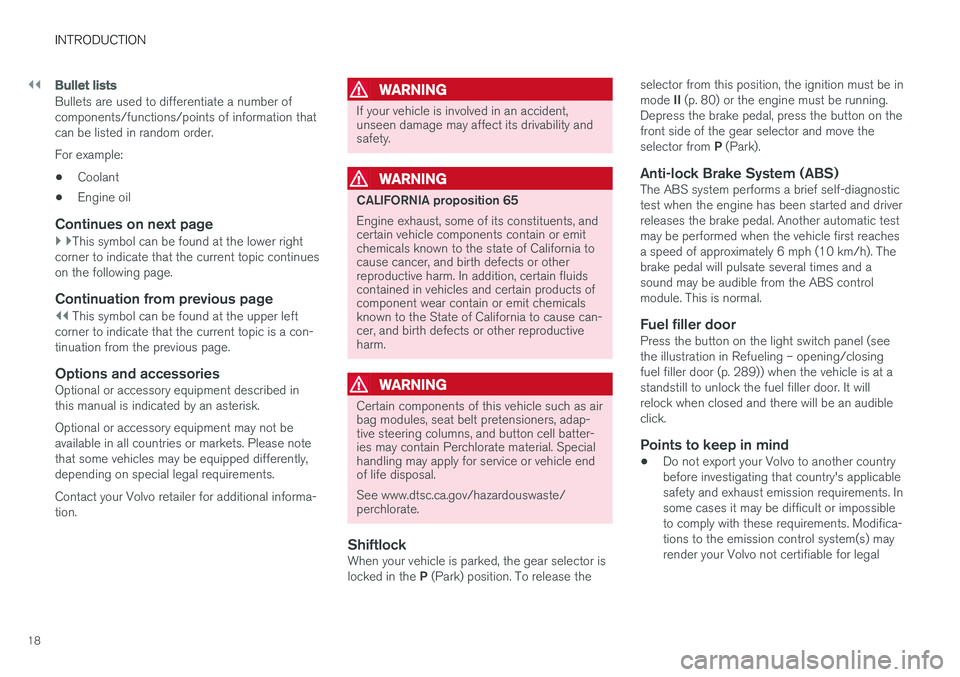
||
INTRODUCTION
18
Bullet lists
Bullets are used to differentiate a number of components/functions/points of information thatcan be listed in random order. For example:• Coolant
• Engine oil
Continues on next page
}
}This symbol can be found at the lower right
corner to indicate that the current topic continues on the following page.
Continuation from previous page
|| This symbol can be found at the upper left
corner to indicate that the current topic is a con- tinuation from the previous page.
Options and accessoriesOptional or accessory equipment described inthis manual is indicated by an asterisk. Optional or accessory equipment may not be available in all countries or markets. Please notethat some vehicles may be equipped differently,depending on special legal requirements. Contact your Volvo retailer for additional informa- tion.
WARNING
If your vehicle is involved in an accident, unseen damage may affect its drivability andsafety.
WARNING
CALIFORNIA proposition 65 Engine exhaust, some of its constituents, and certain vehicle components contain or emitchemicals known to the state of California tocause cancer, and birth defects or otherreproductive harm. In addition, certain fluidscontained in vehicles and certain products ofcomponent wear contain or emit chemicalsknown to the State of California to cause can-cer, and birth defects or other reproductiveharm.
WARNING
Certain components of this vehicle such as air bag modules, seat belt pretensioners, adap-tive steering columns, and button cell batter-ies may contain Perchlorate material. Specialhandling may apply for service or vehicle endof life disposal. See www.dtsc.ca.gov/hazardouswaste/ perchlorate.
ShiftlockWhen your vehicle is parked, the gear selector is locked in the P (Park) position. To release the selector from this position, the ignition must be inmode
II (p. 80) or the engine must be running.
Depress the brake pedal, press the button on the front side of the gear selector and move the selector from P (Park).
Anti-lock Brake System (ABS)The ABS system performs a brief self-diagnostic test when the engine has been started and driverreleases the brake pedal. Another automatic testmay be performed when the vehicle first reachesa speed of approximately 6 mph (10 km/h). Thebrake pedal will pulsate several times and asound may be audible from the ABS controlmodule. This is normal.
Fuel filler doorPress the button on the light switch panel (seethe illustration in Refueling – opening/closingfuel filler door (p. 289)) when the vehicle is at astandstill to unlock the fuel filler door. It willrelock when closed and there will be an audibleclick.
Points to keep in mind
• Do not export your Volvo to another countrybefore investigating that country's applicablesafety and exhaust emission requirements. Insome cases it may be difficult or impossibleto comply with these requirements. Modifica-tions to the emission control system(s) mayrender your Volvo not certifiable for legal
Page 25 of 406
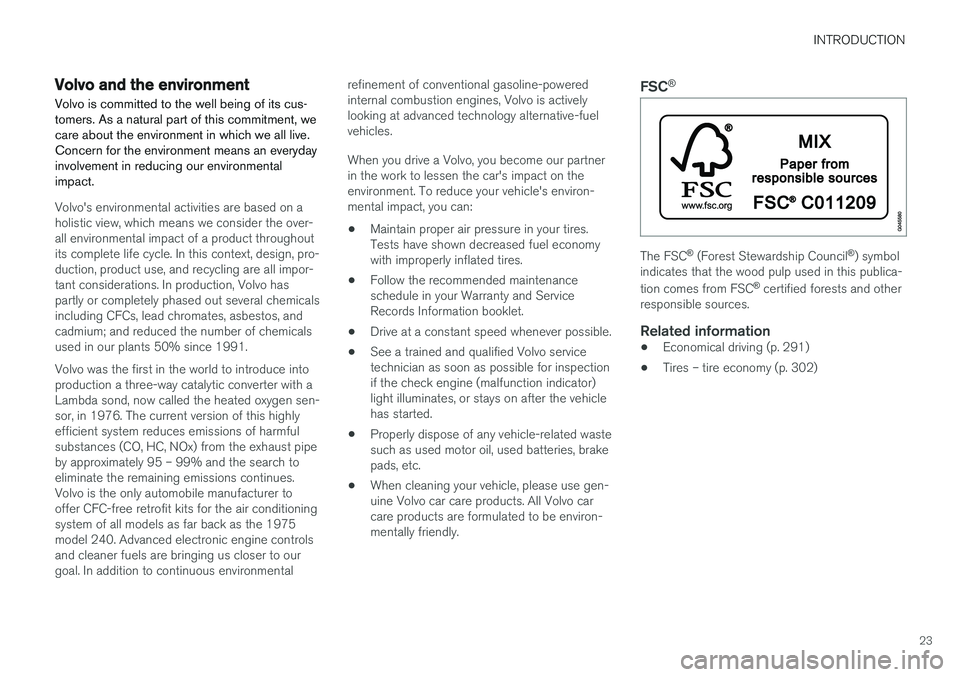
INTRODUCTION
23
Volvo and the environment Volvo is committed to the well being of its cus- tomers. As a natural part of this commitment, wecare about the environment in which we all live.Concern for the environment means an everydayinvolvement in reducing our environmentalimpact.
Volvo's environmental activities are based on a holistic view, which means we consider the over-all environmental impact of a product throughoutits complete life cycle. In this context, design, pro-duction, product use, and recycling are all impor-tant considerations. In production, Volvo haspartly or completely phased out several chemicalsincluding CFCs, lead chromates, asbestos, andcadmium; and reduced the number of chemicalsused in our plants 50% since 1991. Volvo was the first in the world to introduce into production a three-way catalytic converter with aLambda sond, now called the heated oxygen sen-sor, in 1976. The current version of this highlyefficient system reduces emissions of harmfulsubstances (CO, HC, NOx) from the exhaust pipeby approximately 95 – 99% and the search toeliminate the remaining emissions continues.Volvo is the only automobile manufacturer tooffer CFC-free retrofit kits for the air conditioningsystem of all models as far back as the 1975model 240. Advanced electronic engine controlsand cleaner fuels are bringing us closer to ourgoal. In addition to continuous environmentalrefinement of conventional gasoline-poweredinternal combustion engines, Volvo is activelylooking at advanced technology alternative-fuelvehicles. When you drive a Volvo, you become our partner in the work to lessen the car's impact on theenvironment. To reduce your vehicle's environ-mental impact, you can:
• Maintain proper air pressure in your tires.Tests have shown decreased fuel economywith improperly inflated tires.
• Follow the recommended maintenanceschedule in your Warranty and ServiceRecords Information booklet.
• Drive at a constant speed whenever possible.
• See a trained and qualified Volvo servicetechnician as soon as possible for inspectionif the check engine (malfunction indicator)light illuminates, or stays on after the vehiclehas started.
• Properly dispose of any vehicle-related wastesuch as used motor oil, used batteries, brakepads, etc.
• When cleaning your vehicle, please use gen-uine Volvo car care products. All Volvo carcare products are formulated to be environ-mentally friendly.
FSC ®
The FSC
®
(Forest Stewardship Council ®
) symbol
indicates that the wood pulp used in this publica- tion comes from FSC ®
certified forests and other
responsible sources.
Related information
• Economical driving (p. 291)
• Tires – tire economy (p. 302)
Page 30 of 406
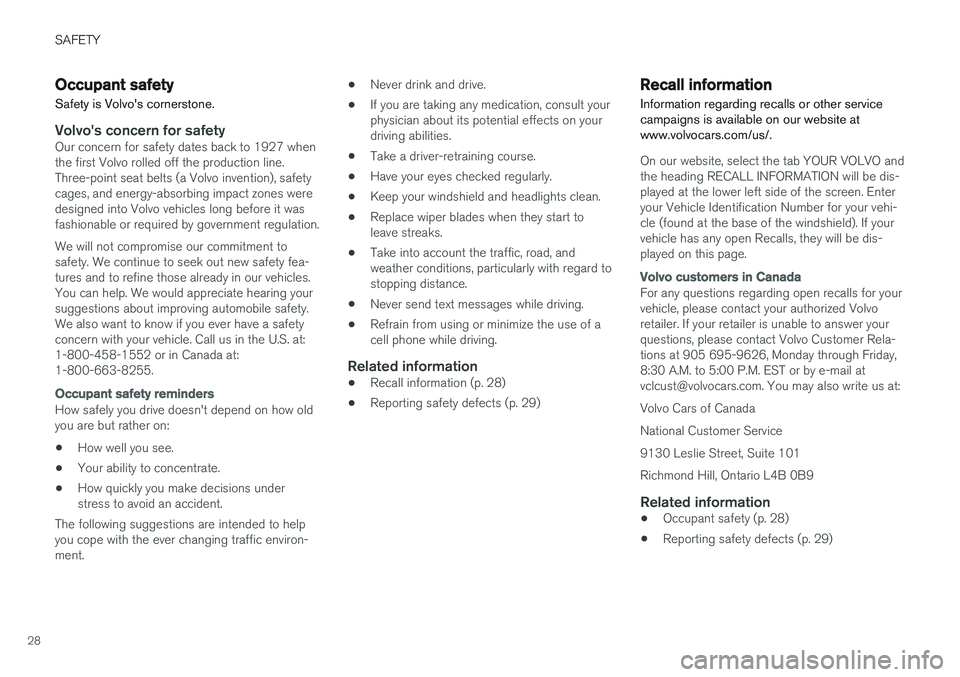
SAFETY
28
Occupant safety Safety is Volvo's cornerstone.
Volvo's concern for safetyOur concern for safety dates back to 1927 when the first Volvo rolled off the production line.Three-point seat belts (a Volvo invention), safetycages, and energy-absorbing impact zones weredesigned into Volvo vehicles long before it wasfashionable or required by government regulation. We will not compromise our commitment to safety. We continue to seek out new safety fea-tures and to refine those already in our vehicles.You can help. We would appreciate hearing yoursuggestions about improving automobile safety.We also want to know if you ever have a safetyconcern with your vehicle. Call us in the U.S. at:1-800-458-1552 or in Canada at:1-800-663-8255.
Occupant safety reminders
How safely you drive doesn't depend on how old you are but rather on:
• How well you see.
• Your ability to concentrate.
• How quickly you make decisions understress to avoid an accident.
The following suggestions are intended to helpyou cope with the ever changing traffic environ-ment. •
Never drink and drive.
• If you are taking any medication, consult yourphysician about its potential effects on yourdriving abilities.
• Take a driver-retraining course.
• Have your eyes checked regularly.
• Keep your windshield and headlights clean.
• Replace wiper blades when they start toleave streaks.
• Take into account the traffic, road, andweather conditions, particularly with regard tostopping distance.
• Never send text messages while driving.
• Refrain from using or minimize the use of acell phone while driving.
Related information
• Recall information (p. 28)
• Reporting safety defects (p. 29)
Recall information Information regarding recalls or other service campaigns is available on our website atwww.volvocars.com/us/.
On our website, select the tab YOUR VOLVO and the heading RECALL INFORMATION will be dis-played at the lower left side of the screen. Enteryour Vehicle Identification Number for your vehi-cle (found at the base of the windshield). If yourvehicle has any open Recalls, they will be dis-played on this page.
Volvo customers in Canada
For any questions regarding open recalls for your vehicle, please contact your authorized Volvoretailer. If your retailer is unable to answer yourquestions, please contact Volvo Customer Rela-tions at 905 695-9626, Monday through Friday,8:30 A.M. to 5:00 P.M. EST or by e-mail [email protected]. You may also write us at: Volvo Cars of CanadaNational Customer Service9130 Leslie Street, Suite 101Richmond Hill, Ontario L4B 0B9
Related information
•Occupant safety (p. 28)
• Reporting safety defects (p. 29)
Page 34 of 406
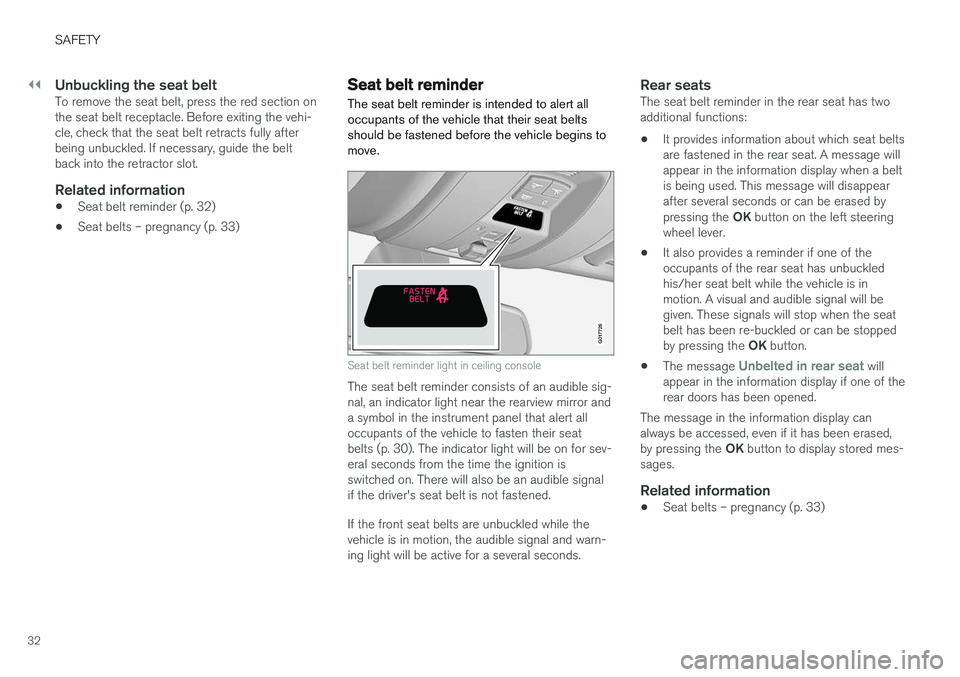
||
SAFETY
32
Unbuckling the seat beltTo remove the seat belt, press the red section on the seat belt receptacle. Before exiting the vehi-cle, check that the seat belt retracts fully afterbeing unbuckled. If necessary, guide the beltback into the retractor slot.
Related information
•Seat belt reminder (p. 32)
• Seat belts – pregnancy (p. 33)
Seat belt reminder The seat belt reminder is intended to alert all occupants of the vehicle that their seat beltsshould be fastened before the vehicle begins tomove.
G017726
Seat belt reminder light in ceiling console
The seat belt reminder consists of an audible sig- nal, an indicator light near the rearview mirror anda symbol in the instrument panel that alert alloccupants of the vehicle to fasten their seatbelts (p. 30). The indicator light will be on for sev-eral seconds from the time the ignition isswitched on. There will also be an audible signalif the driver's seat belt is not fastened. If the front seat belts are unbuckled while the vehicle is in motion, the audible signal and warn-ing light will be active for a several seconds.
Rear seatsThe seat belt reminder in the rear seat has twoadditional functions: • It provides information about which seat belts are fastened in the rear seat. A message willappear in the information display when a beltis being used. This message will disappearafter several seconds or can be erased by pressing the
OK button on the left steering
wheel lever.
• It also provides a reminder if one of the occupants of the rear seat has unbuckledhis/her seat belt while the vehicle is inmotion. A visual and audible signal will begiven. These signals will stop when the seatbelt has been re-buckled or can be stopped by pressing the
OK button.
• The message
Unbelted in rear seat will
appear in the information display if one of the rear doors has been opened.
The message in the information display canalways be accessed, even if it has been erased, by pressing the OK button to display stored mes-
sages.
Related information
• Seat belts – pregnancy (p. 33)
Page 36 of 406
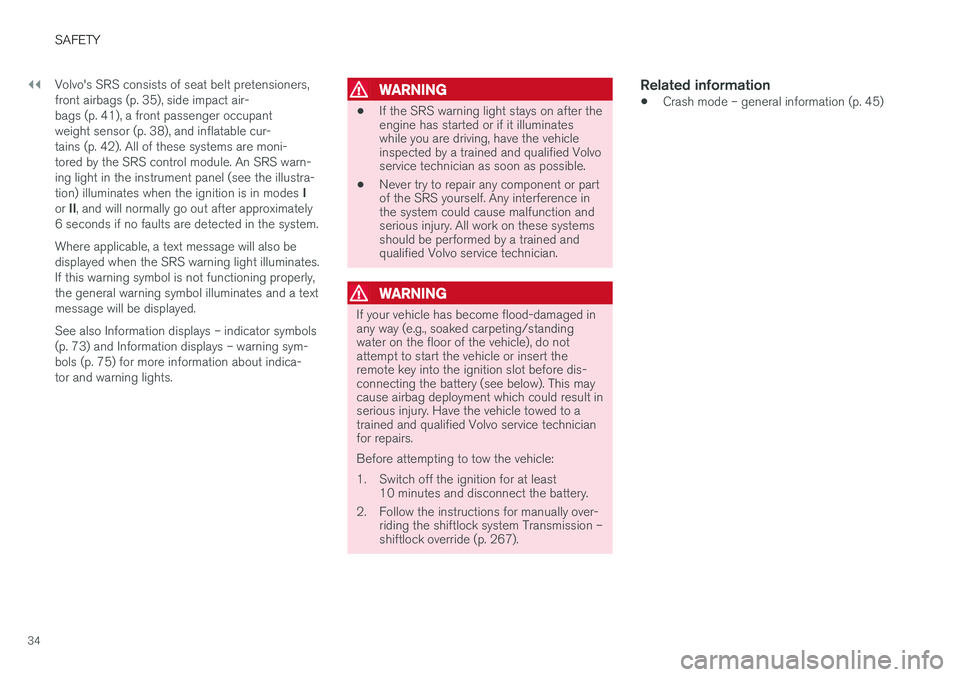
||
SAFETY
34Volvo's SRS consists of seat belt pretensioners, front airbags (p. 35), side impact air-bags (p. 41), a front passenger occupantweight sensor (p. 38), and inflatable cur-tains (p. 42). All of these systems are moni-tored by the SRS control module. An SRS warn-ing light in the instrument panel (see the illustra- tion) illuminates when the ignition is in modes
I
or II, and will normally go out after approximately
6 seconds if no faults are detected in the system. Where applicable, a text message will also be displayed when the SRS warning light illuminates.If this warning symbol is not functioning properly,the general warning symbol illuminates and a textmessage will be displayed. See also Information displays – indicator symbols (p. 73) and Information displays – warning sym-bols (p. 75) for more information about indica-tor and warning lights.
WARNING
• If the SRS warning light stays on after the engine has started or if it illuminateswhile you are driving, have the vehicleinspected by a trained and qualified Volvoservice technician as soon as possible.
• Never try to repair any component or partof the SRS yourself. Any interference inthe system could cause malfunction andserious injury. All work on these systemsshould be performed by a trained andqualified Volvo service technician.
WARNING
If your vehicle has become flood-damaged in any way (e.g., soaked carpeting/standingwater on the floor of the vehicle), do notattempt to start the vehicle or insert theremote key into the ignition slot before dis-connecting the battery (see below). This maycause airbag deployment which could result inserious injury. Have the vehicle towed to atrained and qualified Volvo service technicianfor repairs. Before attempting to tow the vehicle:
1. Switch off the ignition for at least
10 minutes and disconnect the battery.
2. Follow the instructions for manually over- riding the shiftlock system Transmission – shiftlock override (p. 267).
Related information
•Crash mode – general information (p. 45)